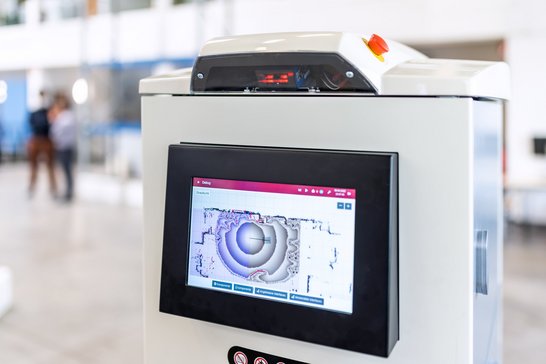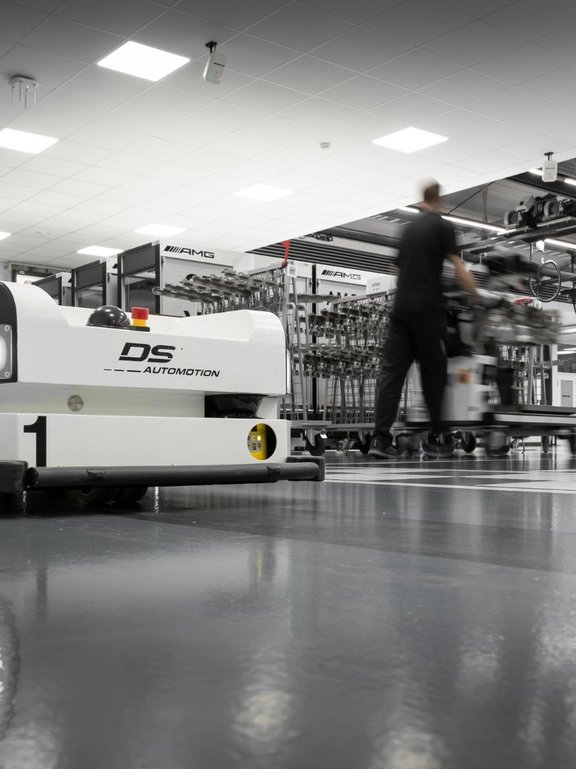Plannable autonomy
What does autonomy mean for automated guided vehicles?
In recent years, the term AMR, "Autonomous Mobile Robot" has become very popular. The difference to the Automated Guided Vehicle (AGV) is the autonomy with which the vehicle can complete tasks. Different gradations can be realized in terms of autonomy. In most cases, these are situational reactions to changing environmental/framework conditions and system states, which are detected and evaluated with the help of multidimensional sensor information.
Plannable autonomy
Plannable autonomy is a term coined at DS Automotion. What is meant by this is the possibility of being able to navigate with vehicles both (virtually) lane-guided and autonomously. The basic building blocks for this are so-called autonomy zones in which the vehicles are allowed to move autonomously. Many AGV manufacturers navigate exclusively lane-guided, while most AMR manufacturers navigate fully autonomously. Our approach is to combine the world of AGVs with the world of AMRs to provide the benefits of both approaches.
Schedulable autonomy allows autonomous functions to be targeted where they bring benefits. Conversely, autonomous functions can be deliberately prevented where they have disadvantages.

Autonomy, flexibility and efficiency
Autonomously navigating vehicles enable greater flexibility in the face of disruptions or obstructions in the working environment. If, for example, the cleaning staff leaves a cleaning trolley on the route, the autonomous vehicle can drive around it, provided there is enough space. Obstacles and disturbances always lower the efficiency of a system and therefore the transport performance of the overall system decreases. In highly automated production, for example, disruptions are prevented as far as possible by means of organizational measures. If an obstacle nevertheless occurs, it can be solved by autonomy. In order to achieve the highest possible efficiency with a good degree of flexibility, the automation must be controllable. For this purpose, DS Automotion has developed the concept of plannable autonomy.
Reactive and cooperative navigation
Dynamic objects located on the travel path are detected by sensors. These are, for example, people or manually guided machines (forklifts, lift trucks, transport carts,...) that move in the same work area. By means of reactive navigation, these can be detected as obstacles and bypassed. To avoid collisions or blockages between autonomous vehicles at intersections, the vehicles must have cooperative navigation. This means that they clarify the right of way independently without having to rely on a central traffic control system.
FAQ
The vehicle's sensors detect the surroundings. Reactive navigation can be used to react to the sensor data and adjust the planned lane and speed at any time.
In path planning, cooperative navigation means taking into account the movements of other vehicles. This means that vehicles cannot travel to the same place at the same time and collisions can be safely prevented.
With complete autonomy, you get the highest flexibility, but you pretty much always lose efficiency. If, for example, there are constant disturbances in the form of obstacles on the route, an AMR must constantly take evasive action and the processing of an order becomes inefficient. It should therefore be carefully considered which autonomous functions are required in an AMR and where this autonomy is to be used in order to achieve the necessary flexibility.
Autonomy does not bring advantages at every point in a system. At bottlenecks or places with high traffic volumes, better solutions can be achieved with fixed lanes and fixed traffic rules. With plannable autonomy, autonomous functions can be switched on and off. This means that the desired behavior of an AMR can already be defined in the planning stage.




